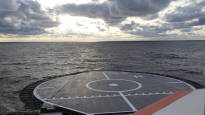Tampere University professor Pami Aalto, who is familiar with Russia and energy policy, answered seven questions about gas pipeline damage.
A leak was noticed in the Balticconnector gas pipeline between Finland and Estonia on Sunday night, October 8. The undersea communication cable has also been broken. On Tuesday, the government held a press conference about what happened.
We asked a professor at the University of Tampere Pami from Aalto seven questions about gas pipe damage. Aalto has familiarized himself with Russia and energy policy in his research work.
What do you think caused the gas pipe to leak and hit the communication cable?
– It could be an accident or sabotage. Sabotage is probably the more likely option at the moment.
What “outside activity” could have caused this?
– An external cause can be, for example, a ship’s anchor that has been dragged on the cable and has caused damage to the pipe. Sabotage is suspected, but we haven’t been told everything.
If it’s sabotage, how sure can you be that Russia is behind it?
– There are only Russian actors who have an interest in disrupting the infrastructure of Finland and Estonia. Russian parties have also mapped gas pipelines, communication cables and other infrastructure in both the North Sea and the Baltic Sea. If the cable was somewhere else, one could suspect a terrorist organization or some other militant entity. There are no such doubts in this case.
How could the damage to the gas pipe have happened?
– If it is sabotage and not damage from a ship, then it has been a reasonably sophisticated operation. We have not been told whether the system has been disturbed and caused a pressure leak in that way, or whether it is an explosion. There is apparently no seismological information about the explosion. In principle, there are many techniques that can be used to cause leakage. They all require some level of sophistication. That’s why it would be strange if some kind of government technology wasn’t involved.
What are the goals of possible sabotage?
– It could be a provocation: Russia has announced that it will respond to Finland’s NATO membership with retaliatory measures. Actions like this are definitely on the list.
– Secondly, Russia is generally at war with the West, the EU and NATO. However, Russia does not want to carry out direct attacks, but rather wants to stay within the limit, so that NATO does not start a consultation in accordance with the fifth article and plan countermeasures.
– Thirdly, Russia wants the West’s attention away from Ukraine. This is also a case of confusion. There are at least three types of motives.
What follows from this?
– The pipe repair operation takes months. Investigations last several days or weeks. We hardly want to go public until we have more detailed information. Consulting allied intelligence also takes some time. There will be no countermeasures until there is clear evidence that Russia is behind this.
How do you assess the significance of what happened, is this historical?
– It definitely is, because this is the beginning. Expert circles have been waiting for this kind of thing to happen for many years. This has been expected. This is part of a continuum where there will be more and more visible attacks and disruptions to critical infrastructure as the situation escalates.
– We are talking about the electricity system, the gas system, the new infras being built. It would also be good to talk about nuclear power plants and their risk levels. Any kind of critical infrastructure is of interest to those who want to disrupt NATO allies.
